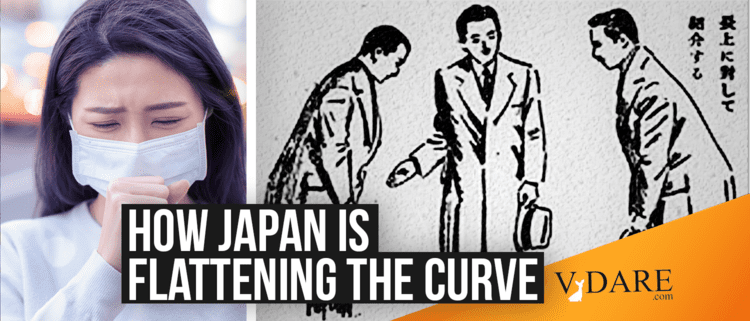


03/19/2020
iSteve commenter Gimeyio writes:
My subjective impression in early March 2020 was that mask wearing in Japan was up significantly from the March norm — normally, I’d expect something like 30-40% of people to be in masks either because they had colds/the flu or because of seasonal allergies. It was up to something like 95% or higher in Tokyo at the start of March, at least in Shinbashi, Ginza, Marunouchi, etc. Unmasked people out in public were quite rare. My impression now is that mask wearing is down, maybe 70-80%, but I suspect that’s partly due to mask shortages. It’s almost impossible to find masks.
In terms of why Japan has not experienced an Italy, I think it’s a combination of:
1. Masks — Japanese regularly mask up in this season, and it’s common courtesy to mask up if you’re experiencing symptoms. So whether it’s the flu or coronavirus, the rate of infection gets reduced.
2. Bows, not handshakes or kisses — self explanatory. Japanese are incredibly sensitive about “skinship” and there’s basically none of it if you aren’t very close to someone, or very drunk. Limits the opportunities for person to person transmission.
3. Everyone goes to the doctor for everything:
Up to late February, I think there were ongoing coordination issues, but at this point, the basic approach of the Japanese healthcare system is to rely on citizens to recognise when they are experiencing [symptoms], and then either go speak with a doctor, or call the consultation hotline. People who get picked up through that route then speak with a doctor who orders a test. There have been reports that doctors have ordered tests and not got them, but it’s not clear what the timing of those problems were — whether they are ongoing today, or were an artifact of the initial ramp up in testing capacity.
All of this depends, however, on people reliably going to the doctor when they are experiencing symptoms. And for the most part, Japanese do. You look at the brief case histories released to the public for newly identified coronavirus patients, and a lot of them are Day 1: had a fever, Day 2: saw a doctor, Day 3: suffered at home, Day 4: saw doctor again, got tested, Day 5: confirmed positive, checked into hospital. It’s not always that quick, but Japan seems to be doing a reasonably good job of picking up symptomatic cases not because of brilliant top-down bureaucratic coordination, but because people just visit the doctor whenever they feel a bit ill, and doctors have been given a procedure to funnel patients into coronavirus testing when it seems warranted.
There’s definitely exceptions — people who have been identified now, where there was a lag of a week or two between when they first experience symptoms and when they get tested, with days when they went into work normally or commuted by public transit in between, potentially infecting others. But they seem to be more the exception than the rule.
And lastly:
4. Luck. If Japan had a Christian group like Shincheonji out there with congregants infecting people en masse and hiding from medical treatment, well, their methodology has a hard time picking up people who don’t show up at the clinic in the first place, and they probably wouldn’t catch it in time to prevent a mass outbreak like what Korea experienced.